| |

PIKES PEAK MEMORIES
The basis of this feature was written for VW Motoring magazine a few years ago, but was never published. So I thought I’d blow the dust off it and upload it to my web site.
It’s really just a good excuse to publish a few more Pikes Peak pictures……
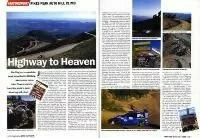 I guess many of you will have seen film of Walter Rohrl blasting his quattro towards the summit of Pikes Peak. May be you were even lucky enough to have been there on race day and witnessed this awesome piece of motorsport history (you did? In that case I’m incredibly jealous!) or alternatively you may have driven the toll road to the summit house whilst on holiday in Colorado. I guess many of you will have seen film of Walter Rohrl blasting his quattro towards the summit of Pikes Peak. May be you were even lucky enough to have been there on race day and witnessed this awesome piece of motorsport history (you did? In that case I’m incredibly jealous!) or alternatively you may have driven the toll road to the summit house whilst on holiday in Colorado.
If so there is every chance that, like me, Pikes Peak will hold a special place in your motorsport memory banks
You against the clock, racing up a 14,110ft mountain, this is the essence of the Pikes Peak International Hill Climb, one of America’s most cherished motorsports events. The 'Race to the Clouds', now synonymous to European race fans for the feats of the Audi and Peugeot Rally teams.
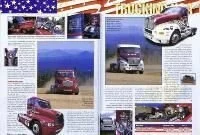 Each year in the lead up to the 4th July – American Independence Day - thousands of race fans crowd onto the mountain that inspired the song “America the Beautiful” to watch competitors, pit their skills against mother nature and try to conquer Pikes Peak. It’s ironic that one of the most beautiful places on earth plays host to what racing legend Parnelli Jones calls “the most dangerous event I’ve ever raced.” Each year in the lead up to the 4th July – American Independence Day - thousands of race fans crowd onto the mountain that inspired the song “America the Beautiful” to watch competitors, pit their skills against mother nature and try to conquer Pikes Peak. It’s ironic that one of the most beautiful places on earth plays host to what racing legend Parnelli Jones calls “the most dangerous event I’ve ever raced.”
Run on a narrow gravel road with no guard rails, the event starts at an elevation of 9,402 feet and culminates atop the formidable Peak at an altitude of 14,110 feet, over 3 miles above sea level. An astounding 42 percent of the course is made up of corners; there are 156 left and right-hand turns.
In 1901 the first winners struggled to the summit in nine hours. These days speeds hit 130mph and the current record is held by Rod Millen’s Toyota in a time of 10m 04.06s, an average speed of an amazing 74.5mph.
Following the demise of the Group B Super Cars during 1986 the factory teams found themselves under-employed, with the latest cars and the most advanced technology ever connected to four wheels and a steering wheel, but with no where to race them.
Audi began to look for a new challenge and decided that Pikes Peak fitted their requirements (although they had been involved since 1982 with their American Rally Champion John Buffum) and team began to build cars specifically for this very special event. By the time the Europeans withdrew, they had conquered ‘Unser Mountain’ as it is affectionally known by the locals and star drivers such as Mouton and Rohrl had left the record book in tatters!
With the European factory teams now a spectacular memory, we thought that it was time to reflect on what the Volkswagen Audi Group achieved in Colorado.
 One of the most important changes to the event came in 1981 when the rally cars first arrived, a variety of classes ran before the format settled on Pikes Peak Open and the fire breathing anything goes Unlimited category. One of the most important changes to the event came in 1981 when the rally cars first arrived, a variety of classes ran before the format settled on Pikes Peak Open and the fire breathing anything goes Unlimited category.
Volkswagen entered the event in 1985 when they built a twin engined Golf, powered by two Oettinger tuned 1.8 GTI engines, the first car producing some 390 bhp.
Despite an impressive 0 - 60mph time of 4.6 seconds and a top speed of some 162mph the car was very much running out of oomph by the time it reached the summit. Former European Rally Champion Jochi Kleint could only manage third in class with a 12m 31.57s run, winning him 'Rookie of the Year' for his efforts.
A second attempt was made the following year using two turbo-charged 1.3 litre Polo engines, the turbo's helped at the higher altitudes but the power band proved to be too narrow and an all new car was built for 1987.
Built to Formula One quality in Austria by Kaimann Racing, the car was of monocoque construction, featuring tubular engine subframes and fully adjustable suspension geometry. At a kerb weight of just 1020kg it was the companies most serious twin engined car to date.
Motivation came from two 16 valve 1.8 litre GTI engines, each powered by KKK turbochargers and producing 320bhp. The engines were mounted longitudinally to allow for the fitting of Hewland five speed gearboxes.
Alas half way through his race run Kleint felt the handling of the car go awry, a broken rose joint in the front suspension saw VW's final attempt come to an end and despite showing promise the team were never to return.
This car can currently be viewed in the Volkswagen factory museum.
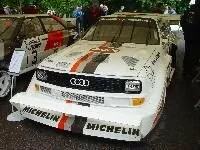 In 1982 American Rally Champion John Buffum arrived with his Audi Quattro and began the years of Audi domination with a victory in the Pro-Rally class, following it up in 1983. In 1982 American Rally Champion John Buffum arrived with his Audi Quattro and began the years of Audi domination with a victory in the Pro-Rally class, following it up in 1983.
It was in 1984 that Audi began to get really serious and World Rally Championship regular Michelle Mouton was picked for the task of establishing a new outright hill record. You can only imagine the reaction of the American faithful when they heard that a woman was hoping to beat their best, being even more shocked when they realised Mouton would be accompanied to the summit by her normal co-driver Fabriza Pons.
The factory team built a new Quattro Sport for their French star, smaller, 200 lbs lighter and with 100bhp more than Buffum’s. To show how serious the team were they paid $6,500 to rent the road for testing and began to set quick times, people began to take notice.
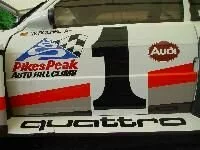 Qualifying was a disaster with Mouton blowing a turbo and struggling to the flag some 90 seconds adrift of Norwegian Rallycross star Martin Schanche's four wheel drive Escort. But race day would be different, the Audi stormed to the summit in 12m 10.38s to set a new class record. Mouton was named 'Rookie of the Year', but the overall win went to Bill Brister's Chevy powered Open Wheeler a further 25 seconds quicker than the Quattro. Qualifying was a disaster with Mouton blowing a turbo and struggling to the flag some 90 seconds adrift of Norwegian Rallycross star Martin Schanche's four wheel drive Escort. But race day would be different, the Audi stormed to the summit in 12m 10.38s to set a new class record. Mouton was named 'Rookie of the Year', but the overall win went to Bill Brister's Chevy powered Open Wheeler a further 25 seconds quicker than the Quattro.
The following year would prove to be Mouton's, but not without controversy and ruffled feathers! During practice Michelle was late for one of her runs and raced into the start area at speed, some of the other drivers thought it dangerous and Mouton ended up with a visit to the Chief Stewards office and a $150 fine.
When it was time for her qualifying run Michelle approached the start line spinning her wheels in an effort to increase the temperature in her tyres and transmission. The Quattro spat dust and rocks at the surrounding drivers and officials. Heated words took place and she was deemed 'reckless', fined a further $500 and restricted to only driving her car on the course. This meant that another crew member drove the car to the start and someone else collected it at the finish line, a very strange arrangement.
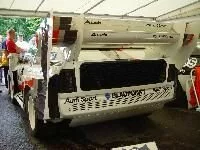 If the Americans thought that this would unsettle the French woman, they were to be proved very wrong indeed. The Quattro roared off the start line and some 5 minutes later smashed the class qualifying record by over 30 seconds and astonishingly took nearly 8 seconds off Bobby Unser Jr's all time qualifying record. If the Americans thought that this would unsettle the French woman, they were to be proved very wrong indeed. The Quattro roared off the start line and some 5 minutes later smashed the class qualifying record by over 30 seconds and astonishingly took nearly 8 seconds off Bobby Unser Jr's all time qualifying record.
Suddenly everyone stood up and took notice, American male pride was taking a battering, was it possibly their great race - a mans race - could be won by a woman?
The answer was an emphatic yes, on race day she launched the Quattro towards the summit and averaging some 66mph - over the 12.42 mile course - she stopped the clocks at 11m 25.39s to become the fastest person ever on the Race to the Clouds.
The sight of a mere woman dominating the 'Race to the Clouds' was too much for the Americans to bare and the following year Bobby Unser convinced Audi that he should have a crack at putting the Unser name back where it belonged.
At the age of 52, after being retired from racing for five years and not having driven the mountain for twelve, Unser - the greatest driver in the history of Pikes Peak - climbed behind the wheel of Sport Quattro S1 and took to the hill.
 As expected the qualifying record fell as Unser became the first driver below 5 minutes and then on race day he hit the summit in a time of 11m 09.22s, some 16 seconds faster than Mouton. As expected the qualifying record fell as Unser became the first driver below 5 minutes and then on race day he hit the summit in a time of 11m 09.22s, some 16 seconds faster than Mouton.
American pride was restored; an Unser was once again the fastest person to drive Pikes Peak.
Unser gave Audi their fifth successive victory in the Open Rally class, but the team seemed disappointed that the 11 minute barrier had not been broken, that would have to wait another 12 months.
In 1987 Audi were joined by Peugeot, the French team fielding three 205 T16's, the two manufacturers pitching World Rally Champions Walter Rohrl and Ari Vatanen against each other.
Audi returned with the same Quattro S1 as used by Unser, but with a vastly different aerodynamic package. The car now looked like a huge Tonka toy with a massive front spoiler, double rear wing and an air duct cut into the roof to feed air into the rear mounted cooling system.
I was lucky enough to have a good look over this dramatic Kevlar bodied car at the 2002 Goodwood Festival of Speed and was amazed at the detail undertaken to shave weight off the car, in an effort to improve its power to weight ratio. The panels felt so light, yet still very rigid, that the doors felt like sheets of paper.
 With an official 600bhp (though who really knows how much power the car really ran with!) from the 2110cc engine and weighing less than 1000kg, this despite being packed with semi-automatic systems and computer technology in both the transmission and engine management. With an official 600bhp (though who really knows how much power the car really ran with!) from the 2110cc engine and weighing less than 1000kg, this despite being packed with semi-automatic systems and computer technology in both the transmission and engine management.
The Pikes Peak Special's performance was awesome. The cars progress up the hill was preceded by the metallic 'clang-clang' of the turbo wastegate as Rohrl worked his way through the cogs in the close ratio six speed gearbox.
Despite being visibly quicker than any other car in a straight line it was Vatanen who was fastest in qualifying, as no less than three of the drivers broke Unser's qualifying record, but it was on race day when the action really began.
It used to be said that experience always ruled the day on the mountain, but the Super Cars and their drivers really ripped up the record books. No less than three 'Rookie drivers' broke the 11 minute barrier, with Rohrl leading the way with a 10m 47.85s run. Vatanen was second some 7 seconds in arrears, followed home by teammate Andrea Zanussi less than two seconds adrift.
 Rohrl gave Audi its sixth successive victory and the first sub 11-minute race time. The company had achieved its goals and now withdrew from Pikes Peak, leaving Peugeot a target to aim at. Rohrl gave Audi its sixth successive victory and the first sub 11-minute race time. The company had achieved its goals and now withdrew from Pikes Peak, leaving Peugeot a target to aim at.
Who knows what might have happened if Vatanen's car had not hit problems. Just 3.5kms into his run a clip on the turbo system failed and robbed the pre-event favourite of perhaps 150bhp, a penalty of over one second per kilometer over the last 16km. The smart money would have been on a Peugeot victory and perhaps we would not have been talking about the awesome Quattro of Walter Rohrl with quite the reverence we do today.
No matter what, the Pikes Peak Special remains the most fearsome Quattro ever built - so far!
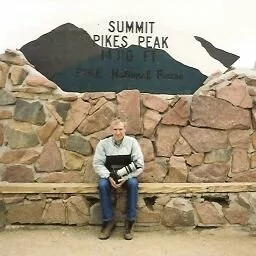 Me playing 'King of the Mountain' on top of Pikes Peak, sitting at the point where Ari Vatanen drank milk when he won the great race! Me playing 'King of the Mountain' on top of Pikes Peak, sitting at the point where Ari Vatanen drank milk when he won the great race!
|
|


